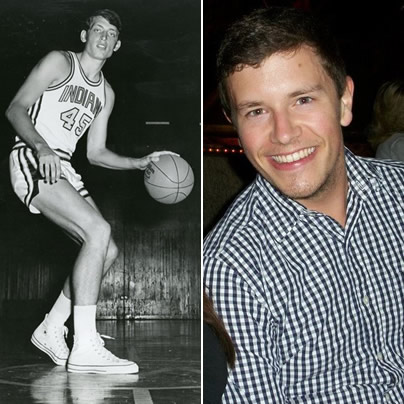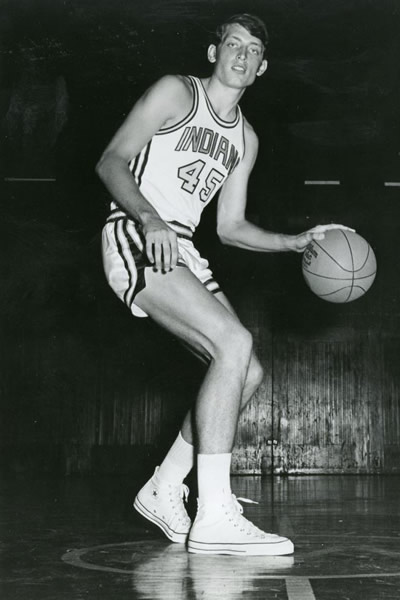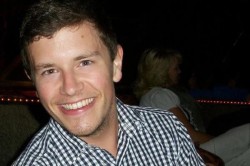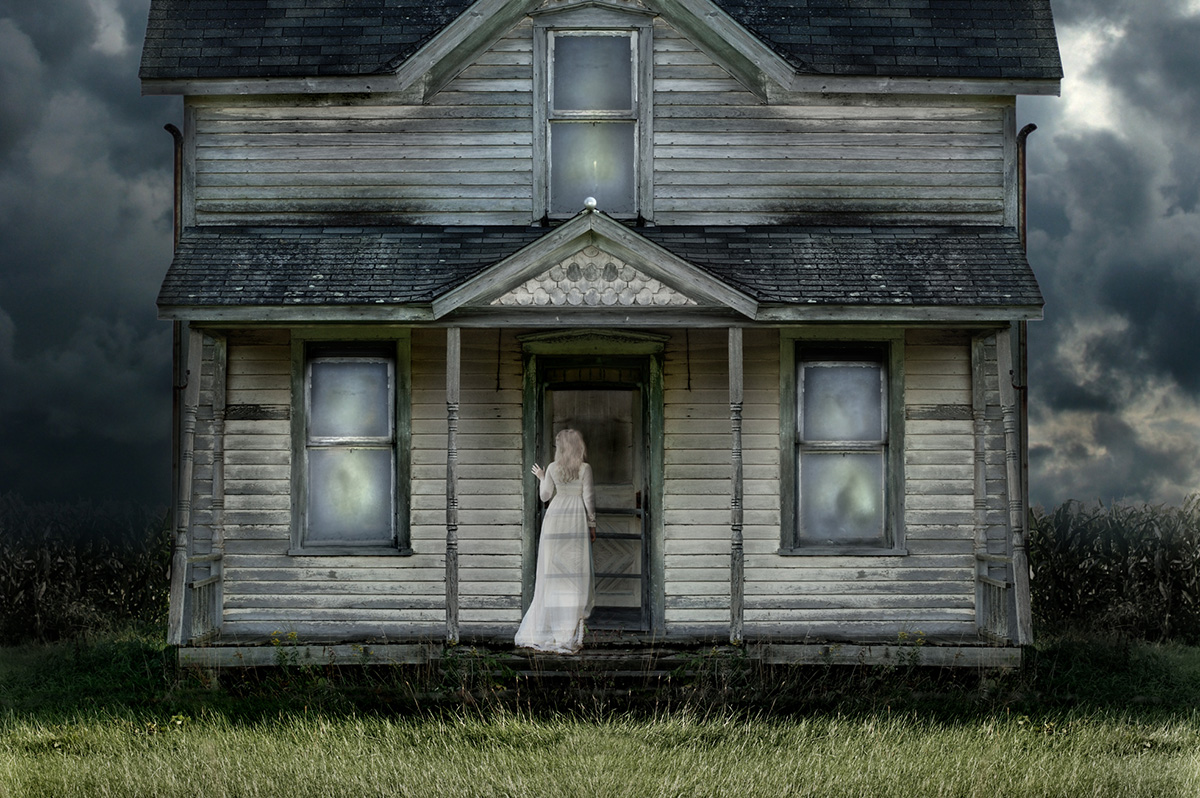Living
Back to School: How it got better at William & Mary
Trammell on the importance of mentoring new generation


The future rector, Jeff Trammell (class of 1973), was captain of the basketball team. (Photo courtesy of Trammell)
Editor’s note: This is the second installment in the “Back To School” series assessing the LGBT climate on university campuses as told by alumni we’re pairing with current students to tell their stories. This week: Jeff Trammell and William & Mary. Next in the series: Lesbian author Fay Jacobs returns to American University.
Speaking of her beloved college, the acclaimed actress Glenn Close once said, “I have an indestructible, visceral connection to this place — a connection which is vital and real and which has sustained me through good times and bad.”
This loving endorsement of William & Mary by Close threads the needle for this series. As we explore the experiences and struggles of gay alumni, the actress known for her roles in “Dangerous Liaisons” and “Fatal Attraction” serves apt imagery.
For Jeff Trammell, in the early 1970s, any same-sex liaisons would have been dangerous — and any attraction could be fatal to his reputation, or worse.
So, while heterosexual classmates were sewing their wild oats, Trammell buried himself in books, basketball and life in the Lambda Chi fraternity. One can picture him with 20 pounds of history books in his backpack, waiting in line to use a public pay phone to call his “date” — a coed with whom only polite conversation would take place. No liaisons, no attractions. The oats he sewed were mild. He only risked coming out once, quietly, to his straight little brother in the fraternity. Much later in life, Trammell would come to lead the Lambda Alliance for LGBTQ’s, but, typical of Trammell, he didn’t drop his ties to Lambda Chi. To this day he is thankful to — and a dear friend of —his little brother and sole confidant, Dave Blount.
Trammell took one shot at wild oats back then. It was a secret mission into D.C. to check out the legendary gay bar, Lost and Found. He arrived at 7 p.m. and entered solo. The bartender just laughed and said, “Come back at 11.” The star senior hoopster was a rookie in gay life so he anxiously sat out in the parking lot. Once inside at the stroke of 11, he saw men dancing with men. As he puts it, “Breathtaking.” But, across the crowded dance floor he spotted the captain of the tennis team, and frightened, he slunk into the shadows, “which is not easy at 6’7″.”
Like many southern boys, Trammell relies on those immortal words from “Steel Magnolias”: “That which doesn’t kill us makes us stronger.” And strong is an understatement. Settled down with Stuart Serkin, his husband with whom he has danced for 36 years, they laugh at having met taking the Florida Bar exam — and Serkin had to coax out of Trammell that his great uncle was indeed “that” former Gov. Trammell of Florida. Their first date was to see “Who’s Afraid of Virginia Woolf” and here they are 36 years later watching the potential reality horror show “Who’s Afraid of Virginia Under Ken Cuccinelli?” But, ever present in their politics, both are at the barricades working for Democratic gubernatorial candidate Terry McAuliffe.
Trammell has worked for Democrats on Capitol Hill for decades, run LGBT outreach for both the Al Gore and John Kerry campaigns and gone toe-to-toe on gay issues with the likes of Sean Hannity and Bill O’Reilly on Fox News. Throughout his life, he has always stayed involved in William & Mary alumni affairs. Last year, he agreed once again to mentor an undergrad — this time Davey McKissick, a senior whose experiences are quite different.
First off, McKissick’s books and phone are both on his iPad, and literally balanced in the palm of his hand. In his other hand? His boyfriend’s. No pay phones, no book bags, no coed “beards.” And if McKissick were single and ran into a gay tennis player, he wouldn’t feel the need to run away. He leads an authentic life. He has learned his gay history through documentaries, lectures at W&M and through Trammell. His ambition was to intern in D.C. and among the 15,000 alumni in the D.C. area, he’s sitting at Trammell and Company with Jeff — the first openly gay board chair (rector) of a major university.
William & Mary elected the first openly gay board chair of a major university in the United States. It didn’t happen in Cambridge, Berkley or Madison. It happened in Williamsburg, Va. “I owe it all to the GALA students and faculty at the university,” Trammell said. “They created the climate for this to happen.” There are many reasons to look up to this former basketball star, and his height isn’t even at the top of the list. Start with McKissick’s gay hero, Barney Frank. It so happens that Trammell co-founded Stonewall Democrats with Frank, so the next thing you know, bang, McKissick is shaking hands with his hero. McKissick is interested in LGBT outreach at the DNC, and poof, he’s sitting in the director, Jeff Marootian’s office, working the Obama-Biden campaign.
When not mentoring students, Trammell can be found funding LGBT lectures at W&M with Chris Bram, fellow alum and the author of “Gods and Monsters,” or helping to fund the Boswell Project, named for John Boswell, class of 1969 — the historian of same-sex relationships in the middle ages. Ironically, Boswell was lost in the AIDS plague. Or you can find Trammell working with David Mixner on the gay issues documented in the U.S. Holocaust Museum. He’s been appointed to the board of the Association of Governing Boards of Universities and Colleges, which represents 38,000+ trustees across the U.S. He’s answering his Blade interview questions at 1 a.m. and then at press time, he’s on the front page of the Washington Post dealing with the new tuition structure. Throughout, his trips to Williamsburg and Richmond are frequent.

Davey McKissick (class of 2014) has led a very different life on campus than his mentor, Jeff Trammell (’73), at William & Mary. (Photo courtesy of McKissick)
Back in Williamsburg, McKissick has already navigated the same gauntlet of traditions Trammell did — swimming the Crim Dell pond, jumping the wall of the Governor’s Mansion, and running the Sunken Gardens. But today, gay campus life is lived in Technicolor with Pride festivals, movie nights and the occasional drag show. There are “safe zones” throughout campus, letting LGBT students know they are welcome.
Reflecting on all this change, Trammell recalls his mother’s reaction late in life to his coming out post-college.
“Well, she was very WASPy and southern and that adds up to being polite,” Trammell said. “She said ‘Oh, honey, I’ve known that for a long time. Now, we don’t need to talk about it’.”
He got unconditional love, but conditional parameters for discussing it. McKissick’s answer to the question about his straight heroes is heart-warming. He answers: “Betty and Ron.” That would be his parents, the McKissicks.
“I could not ask for more supportive influences in my life,” he said. “They motivate me to set high goals for myself and to be relentless in achieving them.” Betty and Ron have no problem talking with — or about — their son.
“It’s remarkable to see Davey is fully out and authentic, things not possible for me back then,” Trammell said. “I think no matter what the size of your alma mater, gay alums should get back involved and support their students.”
As rector, he will officiate commencement at William & Mary Hall this summer, on the same floor he played his first basketball game.
The college marks 1918 as admitting the first woman student and 1951 the first African American. Gays have been there since 1693, but the price to pay for being admitted was no admission of who you were. Those days are steadily fading behind us. Because of its history, W&M has been called “the alma mater of a nation:”
Hark the students voices swelling
Strong and true and clear
Alma Mater’s love their telling
Ringing far and near
Today, each student’s voice is strong and clear. Liaisons aren’t dangerous and attractions aren’t fatal to your reputation. LGBT alumni proudly join Glenn Close in a visceral connection that has sustained them all through the years.
And so, even from a famed Sunken Garden, when he’s standing on Trammell’s shoulders, McKissick can see nothing but rainbows in a clear blue sky ahead of him.
Read the previous installment of this series at washingtonblade.com. If you have alumni stories to share, reach Brent Mundt at [email protected].
Real Estate
Real terrors of homeownership come from neglect, not ghosts
Mold, termites, frayed wires scarier than any poltergeist

Each October, we decorate our homes with cobwebs, skeletons, and flickering jack-o’-lanterns to create that spooky Halloween atmosphere. But for anyone who’s ever been through a home inspection there’s no need for fake scares. Homes can hide terrors that send chills down your spine any time of year. From ghostly noises in the attic to toxic monsters in the basement, here are some of the eeriest (but real) things inspectors and homeowners discover.
Every haunted house movie starts with a creepy basement, and in real life, it’s often just as menacing. Mold, mildew, and hidden water leaks lurk down there like invisible phantoms. At first, it’s just a musty smell — something you might brush off as “old house syndrome,” but soon enough, you realize those black or green patches creeping along the walls can be more sinister than any poltergeist.
Black mold (Stachybotrys chartarum) is particularly fearsome – it thrives in damp, dark places and can cause serious respiratory problems. It’s not just gross – it’s toxic and, while some types of mold can be easily cleaned up, removing black mold can cost more than an exorcism.
Have you ever heard strange buzzing or seen flickering lights that seem to move on their own? Before you call the Ghostbusters, call an electrician. Faulty wiring, outdated panels, and aluminum circuits from the mid-20th century are the true villains behind many mysterious house fires. Home inspectors can also find open junction boxes, frayed wires stuffed behind walls, or overloaded breaker panels that hum like a restless spirit.
Imagine an invisible specter floating through your home – something that’s been there since the 1950s, waiting for you to disturb it. That’s asbestos. Home inspectors dread discovering asbestos insulation around old boilers or wrapped around ductwork. It’s often lurking in popcorn ceilings, floor tiles, and even wall plaster. You can’t see it, smell it, or feel it—but inhaling those microscopic fibers can lead to serious illness decades later.
Lead pipes, once thought to be durable and reliable, are like the vampires of your water system – quietly poisoning what sustains you. The results of a lead test can be chilling: even a small amount of lead exposure is dangerous, particularly for children.
And it’s not just pipes – lead paint is another problem that refuses to die. You might find it sealed beneath layers of newer paint, biding its time until it chips or flakes away. This is why, when selling a property built prior to 1978, homeowners must disclose any knowledge of lead paint in the home and provide any records they may have of its presence or abatement.
Scratching in the walls. Tiny footsteps overhead. Droppings in the attic. It’s not a poltergeist – it’s pests. Termites, rats, bats, carpenter ants, and even raccoons can do more damage than any ghost ever could.
Termites are the silent assassins of the home world, chewing through beams and joists until the structure itself starts to sag. Rats and mice leave behind droppings that can spread disease and contaminate food. Bats are federally protected, meaning your haunted attic guests can’t just be evicted without proper precautions. And I once had a raccoon give birth in my chimney flue; my dogs went crazy.
Ever step into a home and feel the floors tilt under your feet? That’s no ghostly illusion – it’s the foundation shifting beneath you. Cracked walls, doors that won’t close, and windows that rattle in their frames are the architectural equivalent of a horror movie scream.
Foundation damage can come from settling soil, poor drainage, or tree roots rising from under the structure. In extreme cases, inspectors find entire crawl spaces flooded, joists eaten by rot, or support beams cracked like brittle bones. Repair costs can be monstrous – and if left unchecked, the whole house could become a haunted ruin.
Some homes hold more than just physical scares. Behind the drywall or under the floorboards, inspectors may uncover personal relics – old letters, photographs, even hidden safes or forgotten rooms. Occasionally, however, there are stranger finds: jars of preserved “specimens,” taxidermy gone wrong, or mysterious symbols scrawled in attic spaces.
These discoveries tell stories of the people who lived there before, sometimes fascinating, sometimes chilling, but they all add to the eerie charm of an old home, reminding us that every house has a history — and some histories don’t like to stay buried.
So, while haunted houses may be a Halloween fantasy, the real terrors in homeownership come from neglect, not ghosts. Regular inspections, good maintenance, and modern updates are the garlic and holy water that turn a trick of a home into a treat.
Valerie M. Blake is a licensed associate broker in D.C., Maryland, and Virginia with RLAH @properties. Call or text her at 202-246-8602, email her via DCHomeQuest.com, or follow her on Facebook at TheRealst8ofAffairs.
Advice
Sexual desire is waning, should we open our relationship?
Couple faces difficult choices after seven years

Dear Michael,
When I met my husband seven years ago, I was super attracted to him and we had a really hot sex life.
That feeling has been waning for a while and now I am just not feeling it.
I know that people get older, gain weight, get less attractive over time but that’s not the case here. Ben is as good looking as ever. But I have little desire to have sex with him.
It bothers me that I don’t really want to have sex with the guy I love and want to spend the rest of my life with.
Is this why everyone else I know has an open relationship? Is there something I can do to want to have sex with my husband again?
This is causing major problems in my marriage. I don’t initiate anymore and half the time I find an excuse to not have sex when Ben initiates. He knows something is up but I usually blame it on work stress or not feeling well. I don’t want to hurt his feelings.
Aside from this, I love Ben and we have a lot of fun together. We’re very close, talk about all sorts of stuff, but not this.
Michael replies:
Pretty much everyone in a long-term relationship has to deal with decreased desire at some point.
Sex changes after you’ve been with your partner for a while. Sex is not going to be as easy, hot, and irresistible as it was at the beginning of the relationship. Newness generates a lot of the sexual heat at the outset of a relationship, and when the newness is gone, you don’t easily feel the same sizzling excitement that you felt when you first met.
Unfortunately, the kind of sex that people have at the beginning of a relationship is totally glorified in our culture as the gold standard of sex.
I say “unfortunately” because it’s not possible to consistently have the hot sex of a new relationship, ongoing, with a long-term partner. So if you think that is the best or only kind of sex to have, you will be contemptuous of anything else, and you will be disappointed in your sex life with your partner as time marches on.
But the sizzling sex people have at the start of a relationship is just one way to have sex. If you are willing to be imaginative, and are open to change, there are many other kinds of sex that can be wonderful.
How about sex for emotional connection? Sex for physical closeness? Sex for romance? Sex to celebrate just being together?
So, consider changing (not lowering!) your expectations. Rather than sulking or moping that you don’t want to spontaneously jump Ben’s bones, be open to having sex with your husband that is based more on your relationship and on your love for each other.
Now, here’s a whole other angle to consider: While the excitement of a new partner often fades, there are still ways to generate excitement and passion in a long-term relationship by taking risks and revealing yourself more deeply. Stick with me and I’ll explain.
- You haven’t said anything to Ben about your waning interest. I encourage you to re-think this. You would be much better positioned to tackle this issue collaboratively. Not talking about how stuck you feel is likely to deepen your feeling of shame and fear that something is wrong. Speaking with Ben about what is actually a fairly common couples’ issue could be a relief.
- Ironic as this may seem, the closer two people are, the less comfortable they may be being frankly sexual with each other. Clients often tell me that they are more comfortable expressing their real desires to someone they hardly know (or don’t know at all) than to their significant other. For one thing, the more your partner means to you, the more you may fear rejection if you reveal sexual feelings and desires that might upset or even shock your partner. For another, as couples get closer, sex may start to feel like too much closeness, and avoiding sex may be a way to create some space.
Not speaking up about what is important keeps you distant from your partner and drains your relationship of vitality. A powerful antidote to this: work toward becoming a person who can take risks, tolerate discomfort and uncertainty, and be able stand on your own when you don’t get your partner’s validation.
Talking with Ben, whether it’s about your lack of spontaneous desire for sex, or about sexual interests you may be keeping from him for fear of judgment, would involve your making uncomfortable moves that might lead to Ben’s judgment or even rejection. But doing so would also, of course, allow the possibility of more happening between you sexually. It would also let Ben know you better, thereby deepening the level of intimacy in your relationship. Making these moves could also be inherently exciting, which —guess what—could help to shake you out of your sexual doldrums and bring more passion and life into your relationship.
Similarly, you might start initiating. Even if you’re afraid it won’t go well and even if you’re not feeling it. That is the only way you are going to figure out how to have satisfying long-term sex. Take the need for an erection or orgasm off the table. Sex with your partner should not be a performance. Go for closeness, connection, and what feels good. And challenge yourself to go places that you are uncomfortable about going.
If any of this intrigues you, “Passionate Marriage” and “Intimacy and Desire,” both by David Schnarch, explore how your sexual connection can deepen over time in a long-term relationship.
Finally, with regard to your considering an open relationship as a remedy: Do you think that would enhance the sexual connection between you and Ben?
Michael Radkowsky, Psy.D. is a licensed psychologist who works with couples and individuals in D.C. He can be found online at michaelradkowsky.com. All identifying information has been changed for reasons of confidentiality. Have a question? Send it to [email protected].
Wedding Announcement
Douglas M. Haller and Timothy H. Longnecker wed in Detroit, Michigan
Couple weds in Detroit, Michigan

Douglas M. Haller and Timothy H. Longnecker were married on September 15, 2025 in Detroit’s gay-welcoming suburb Ferndale after 11 years as domestic partners in Midtown Detroit. Julia Music, coordinator of LGBTQ Pride celebrations in Ferndale, served as officiant.
The couple sang stanzas of the 1927 song “Side By Side” as their vows, concluding with an AI Gay Wedding Pledge: “to be Allies pursuing happiness, equality and shared dreams.”
The couples’ families hail from Detroit’s Old Redford neighborhood; Douglas is Irish and French-Canadian, Timothy is German and English. DNA testing confirmed to the couple that each shares substantial ancestry from Ostrobothnia, Finland.
Douglas began his advocacy as a gay cultural and political activist in 1971 by coming out in the disco dance scene of Detroit’s Gay Palmer Park neighborhood. In Washington, D.C. after 1974, he was an interior designer at Georgetown’s Little Caledonia boutique. Douglas became the co-owner of Hermes Antiques with Helen Coutts, a retired English Literature teacher from Redford H.S. On S St. at Connecticut Ave., D.C.’s first Pride celebrations were held in front of their shop, alongside Lambda Rising bookstore. Following victimization in an anti-gay hate attack, Douglas became the public awareness coordinator of the Gay Activists Alliance, and was the principal organizer of its Anita Bryant demonstration at Dupont Circle.
Returning to Detroit in 1979, Douglas achieved an M.A. in Ancient History & Archival Administration at Wayne State University (WSU), studying under Finley Hooper & Philip Mason; his Master’s Essay re: an American Labor Movement cartoonist, utilizing the Walter Reuther Library’s archives. His WSU 1973 B.A. included American Political/ Diplomatic History, & Interdisciplinary Studies. During 1979-82 he was Information Officer of ASP (Assoc. of Suburban People)— Metro Detroit’s largest gay and lesbian social and political organization.
Douglas relocated toSan Francisco in 1982. He was Curator of Photographs at California Historical Society Libraries in Pacific Heights and Los Angeles. Living in the Mission & Haight, he was active in Castro and South-of-Market gay life, just as the HIV/AIDS epidemic first appeared.
In 1986 Douglas relocated to Philadelphia, as Head Archivist of the University of Pennsylvania Museum of Archaeology/Anthropology; authoring an illustrated book on Maison Bonfils, 19th-century French photographers of the Near East. Douglas was Founding Archivist of Penguin Place, now Philadelphia’s William Way LGBT+ Community Center. He became a Charter Member, Academy of Certified Archivists; and Founding Member, Lesbian/ Gay Archives Roundtable, Soc. of American Archivists (Chicago).
Returning to WSU’s Reuther Library (1998), Douglas was Coordinator of Audiovisual Collections, & History of Photography Instructor. Following 9/11 Attacks (2001), he relocated to New Orleans as Head Curator of Louisiana State Museums. Later owning the Gay-welcoming Creole Inn B&B in the Marigny (nr the French Quarter), with his finger on the pulse of Nawlins’ Gaylife—until Hurricane Katrina (2005). GLBT+ neighborhoods weren’t inundated—becoming lively islands amidst destruction. Douglas returned to Detroit in 2008 as caregiver for his mother, Jeanette Kalahar (Haller) Marchand, formerly a radio singer in 1940s Detroit. He met Timothy in 2014.
Timothy achieved a 1991 MBA in Finance & 1985 BS in Management Information Systems from the Univ. of Michigan-Ann Arbor. During 30 years, he held Information Technology & Automotive Business positions in Metro Detroit & LA, including Partner at Deloitte & Touche, Ford Motor & IBM. As a Consultant, his work involved extensive travel in North America, Europe & Asia. He has two married daughters from a previous marriage, a Pediatric Cardiology Nurse Practitioner & a Recruiting Executive for Automotive Technology clients, both living in Metro Detroit. As their final project before retirement, Timothy & Douglas worked as Archivist & Technology Consultant for Detroit educators Harriet (Choreographer) & Irving (Sculptor) Berg. Harriet acted as a godmother during their early relationship & they assisted in caregiving during her final years.
Timothy and Douglas spend their retirement in a 1905 apartment near the Detroit Institute of Arts’ exhibits, films and concerts, enjoying ethnic restaurants, and traveling. In 2025 they went by train to experience the “First Homosexuals 1869-1939” exhibition in Chicago. The curator of the exhibition, Jonathan Katz, 1976 book “Gay American History”, inspired Douglas to become a gay archivist.
-

 District of Columbia20 hours ago
District of Columbia20 hours ago‘Sandwich guy’ not guilty in assault case
-

 Sports1 day ago
Sports1 day agoGay speedskater racing toward a more inclusive future in sports
-

 Celebrity News3 days ago
Celebrity News3 days agoJonathan Bailey is People’s first openly gay ‘Sexiest Man Alive’
-

 Theater5 days ago
Theater5 days agoReggie White explores the many definitions of home in ‘Fremont Ave.’



















